
The Economist
May 5th 2018
Finance and economics 67
2
Trump’s trade team was expected to raise
this complaint, among others, with Chi-
nese officials during talks inBeijing onMay
3rdand4th, as
The Economist
went topress.
There is one problem. Data suggest that
competition with China has coincided
withmore innovation inAmerica, not less.
The relationship between competition
and innovation is complex, even before
considering trade with China. Economists
agree that the right competitive landscape
fosters innovation. But theydisagree about
what exactly that landscape looks like.
More competition might prod companies
to try harder to develop new products in
the hope of gaining market share. Alterna-
tively, if competition is cut-throat, profits
might evaporate to the point that compa-
nies have little incentive to take risks.
The fear is that China generates the
wrong kind of competition and stunts the
good kind. Businesspeople elsewhere
worry that when the Chinese government
decides to fund this or that industry, invest-
ment soars and margins collapse. Over-
capacity in steel was caused in part by Chi-
nese investment in steel processing;
semiconductor firms think their industry
might be next. At the same time, argues
Robert Lighthizer, the
US
Trade Representa-
tive, foreign companies that beat their Chi-
nese competitors are not adequately re-
warded because China presses them to
transfer their intellectual property.
The two main academic papers on this
question looked at the years around Chi-
na’s accession to the World Trade Organi-
sation in 2001. Far from settling the matter,
they were contradictory. Economists
studying European companies found that
competition from Chinese imports both
caused firms to improve their technology
and led to a shift in jobs to the most ad-
vanced firms. They concluded that 15% of
the upgrading of technology in Europe be-
tween 2000 and 2007 could be attributed
to the increase in imports from China. But
economists examining the impact on
America argued that, on the contrary, Chi-
nese competition had led companies to
spend less on research as profits fell. They
calculated that imports from China ex-
plained 40% of a slowdown in American
patenting between 1999 and 2007, com-
paredwith the preceding decade.
The
IMF
has now weighed in with
more recent figures. Its conclusion is rather
more cheerful, at least for those who think
a tradewarwith China is a rotten idea. In a
report published in April the fund showed
that, following an extended period of de-
cline, high-quality patents granted to
American companies had risen sharply
between 2010 and 2014. It also pointed to a
big increase in American spending on re-
search and development during the same
years—even as America’s trade deficit with
China rocketed (see chart on previous
page). The growth in patents was more
sluggish in Europe and Japan. But both pat-
ents and research spending soared in
South Korea, the country most directly ex-
posed to manufacturing competition from
China.
A separate
IMF
working paper late last
year unpicked some of what is happening
inAmerica. Competition fromChinese im-
ports has caused research spending to be
reallocatedwithin certain industries, away
from also-rans and towards the most pro-
ductive and profitable firms. At the same
time, many researchers left manufacturing
industries and moved into service sectors
such as data-processing and finance. Both
results are consistent with an American
economy that is playing to its strengths.
The
IMF
’s analysts concluded that Chinese
imports were not a threat to innovation in
America, after all, and that policymakers
could take a deep breath. No loud inhaling
sounds have yet been reported from the
White House.
7
Returns to education
Smart investment
W
HICHhas provided a better return
in recent decades: America’s stock-
market or education? The latter, accord-
ing to a research reviewbyGeorge Psa-
charopoulos andHarry Patrinos for the
World Bank. The two economists looked
at1,120 studies, across139 countries, and
came upwith an annual average “rate of
return”—actually a pay premium, the
increase in hourly earnings froman extra
year of schooling—of 8.8%. The analogy is
inexact, but for comparison America’s
stockmarket returned an annual 5.6%
over the past 50 years.
Their figure excludes social gains, such
as lowermortality rates associatedwith
greater education. The premium is higher
for girls and for primary education. It is
also higher in poor countries, presum-
ably because the smaller the share of
educated people, the higher the pay they
can command. The same reasoning
suggests that the return should have
dwindled as educational attainment
rose. Instead, it has stayed strong, espe-
cially for higher education (see chart).
Some researchers have posited that
technological advances have displaced
some skilledworkers, who have then in
turn displaced less-skilled ones, leaving
their relative positions in the pecking
order—and thus the return to their extra
education—little changed. Mr Psacharo-
poulos andMr Patrinos aremore san-
guine. They think theworld iswitnessing
a “race between education and tech-
nology”. A rising number of degree-
holders has tended to push returns
down, but rising demand for higher-level
skills, driven by the speed of technologi-
cal change, hasworked in the opposite
direction. Technology seems to have
beenwinning.
Rising returns increase the incentive
to invest in education. Governments and
individuals seem to be responding. Pub-
lic spending on education as a share of
GDP
is growing; private education, both
at school and tertiary level, is booming.
The beneficiaries are peoplewho have
access to education, either because they
live in rich, well-governed countries or
because they can afford to pay privately
for it. Rising returns, saysMr Patrinos,
signal to individuals to invest more. But
they alsomean that anyonewho does
not will fall further behind. “Eitherway,
the conclusion is the same: invest now.”
Even thoughmore people are doing it, studying still pays off
Honour roll
Source: George Psacharopoulos and
Harry Patrinos, World Bank
Global higher education
Rate of return
Annualised, %
Enrolment
As % of population
0
10
20
30
1970 90 2010
0
10
20
30
1970 90 2010
РЕЛИЗ ПОДГОТОВИЛА ГРУППА "What's News"
VK.COM/WSNWS







